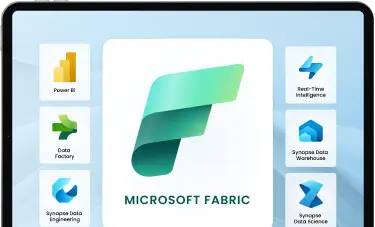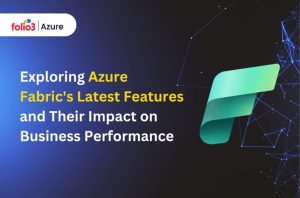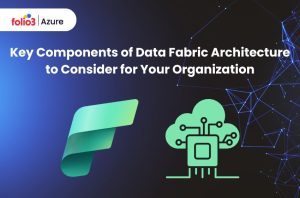Table of Contents
ToggleThe business sector today has become intense and demanding owing to various factors. Efficient supply chain reporting is the lifeline for thriving successfully and maintaining a competitive edge. Impeccable data, real-time insights, and practical reporting tools are the key factors contributing to empowering stakeholders to make informed decisions.
Implementing Microsoft Fabric for supply chain reporting provides a reliable, efficient, and swift solution to remodel your supply chain management operations. This article highlights the advantages and steps in integrating Fabric-based supply chain solutions to refine your reporting capabilities.
Accelerate smart decisions with Microsoft Fabric's unified data and AI analytics.

Common Challenges in Supply Chain Reporting
Among the many difficulties supply chain reporting faces are data fragmentation, inadequate real-time visibility, and ineffective data integration. Supply chain data integration is a common challenge for traditional systems, resulting in reporting delays and errors.
Furthermore, the inability to monitor in real-time makes it more difficult to react quickly to disruptions. These difficulties emphasize the demand for modern technologies that provide thorough and immediate insights, such as Microsoft Fabric supply chain analytics.
1. Data Fragmentation
One of the main issues in supply chain reporting is data fragmentation. Supply chains usually involve multiple stakeholders, with each one using different system to manage their operations. This results in disparate data across different platforms. Thus making it difficult to have a unified view of the supply chain.
Supply chain data integration is mandatory to overcome this fragmentation of data, and Microsoft Fabric provides the features to collect and merge data from scattered sources. By collecting data on a single platform, you can ensure data consistency and accuracy that leads to better analysis and decisions.
2. Lack of Real-Time Visibility
Without real-time visibility of data, businesses cannot respond quickly to problems such as delays, disturbances, or variations in demand. Traditional reporting methods usually provide obsolete data, which cannot help in proactive decisions.
Microsoft Fabric empowers your with real-time supply chain monitoring, this way you can have access to up-to-date information, enabling prompt action and better decision-making. This real-time access can reduce response times and improve boost efficiency.
3. Inefficient Data Integration
Merging data from disparate sources is a major challenge for many businesses. Incompatible data formats and siloed systems can be a hurdle in the transfer of information. Thus resulting in incomplete or error prone reports.
Microsoft Fabric tackles this problem by providing easy supply chain data integration, this empowers you to compile effectively and analyze data from all parts of your supply chain. This integration also helps in creating a complete view of the supply chain.
Accelerate smart decisions with Microsoft Fabric's unified data and AI analytics.

Overview of Microsoft Fabric and Its Relevance to Supply Chain Reporting
Microsoft Fabric is a modern and innovative platform designed especially to provide real-time data and analytics. It integrates easily with the existing systems, providing a complete solution for supply chain data integration.
The platform’s features for real-time supply chain monitoring and advanced data modeling make it perfect for handling the intricacies of complex supply chains. By utilizing data visualization in supply chain management, Microsoft Fabric enables you to transform raw data into valuable information.
Real-Time Intelligence
Microsoft Fabric’s real-time intelligence features are specifically ideal for supply chain reporting. With the aid of real-time supply chain monitoring, you can monitor your shipments, stock levels, and production levels in real-time. This helps in swift identification of hurdles, enabling you to take immediate corrective actions.
Monitoring supply chain activities in real-time increases operational efficiency and reduces the risk of delays. Real-time intelligence ensures that you are always aware of the current state of your supply chain, enabling more responsive management.
Seamless Integration
The platform’s easy integration features are a huge benefit for businesses aiming to improve their supply chain reporting. Microsoft Fabric can connect with various data sources, including ERP, warehouse, and transportation management systems.
This ensures that all required data is collected at a single platform, facilitating an all-encompassing supply chain data integration and reporting. Smooth data integration minimizes the complexity and time needed to gather and process data. Therefore making it a breeze to maintain records.
Advanced Data Modeling
Microsoft Fabric is embedded with another key features that is advanced data modeling. By employing advanced data models, you can evaluate complex supply chain processes and identify areas for improvement.
Data modeling for supply chain analytics greatly aids in comprehending the connections between different variables, such as lead times, stock levels, and demand variations. This in-depth knowledge leads to accurate forecasting and better decision-making. Advanced data modeling also enables the simulation of various scenarios, helping you to prepare for possible hurdles and simplify your supply chain processes.
Advantages of Using Microsoft Fabric for Supply Chain Reporting
You can gain immense benefits by implementing Microsoft Fabric for supply chain reporting. The platform boosts real-time supply chain monitoring, empowering you to monitor all processes of your supply chain with high accuracy. Its prompt supply chain reporting tools help you to generate detailed reports and data visuals, leading to transparency.
Moreover the integration of Power BI and Microsoft Fabric provides powerful data visualization features. By the using it you can spot trends and enhance performance. Altogether these capabilities boost supply chain performance metrics, helping you attain high levels of efficiency and effectiveness.
Enhanced Monitoring
Another major advantage of Microsoft Fabric is its intelligent monitoring capabilities. By providing real-time supply chain monitoring, Microsoft Fabric ensures that you the latest information about your supply chain operations.
This real-time data helps you to identify issues before they become major hurdles, and take rectifying actions promptly. Enhanced monitoring helps to maintain smooth operations.
Detailed Reporting and Visualization
With the help of Microsoft Fabric’s efficient supply chain reporting tools you can create detailed reports and visualizations. These tools make it easy to analyze data and get deep knowledge about your supply chain performance.
The integration with Power BI and Microsoft Fabric further refines these capabilities, providing advanced data visualization options that help in identifying trends, patterns, and anomalies.
These in-depth visualization smoothen the communication and give deeper insights to stakeholders, facilitating better understanding and decision-making.
Improved Transparency and Accountability
Transparency and accountability make up an important duo for efficient supply chain management. Microsoft Fabric greatly refines both by providing a collective platform for supply chain data. This combined view empowers stakeholders to have access to the same information, improving collaboration and accountability.
The platform’s advanced reporting and visualization modules also aid in providing transparency and ease of communicating the supply chain performance metrics. Improved transparency helps build trust among stakeholders and ensures that everyone is aware of the organization’s goals.
Optimization and Efficiency
Implementing supply chain optimization with Fabric can significantly proficiency and effectiveness. By providing real-time insights and advanced analytics, Microsoft Fabric helps you identify areas for improvement and optimize your supply chain operations.
This can result in cost savings, improved service levels, and better performance. Enhanced efficiency boosts productivity and contributes to a more sustainable and strong supply chain.
Integrating Microsoft Fabric with Supply Chain Systems
Integrating Microsoft Fabric with your current supply chain systems consists of several steps. First, assess your systems and spot areas where supply chain optimization with Fabric can be beneficial.
Next, plan the integration, ensuring all data sources are connected correctly. Employ data modeling for supply chain analytics to structure your data. Finally, use the supply chain reporting tools provided by Microsoft Fabric to generate real-time insights and refine your operations.
Steps to Integrate Microsoft Fabric with Existing Supply Chain Systems
Follow these steps to successfully integrate Microsoft Fabric with your supply chain systems.
- Assessment and Planning: Analyze your current supply chain systems and identify the areas for improvement. Understand how Microsoft Fabric supply chain analytics can align with your needs. This step involves a deep analysis of your existing processes, identifying pain points, and setting clear targets for the integration.
- Data Integration: In the next step connect all related data sources to the Microsoft Fabric platform. Ensure smooth supply chain data integration to help gain detailed analytics. This may consist of using connectors and APIs to integrate various systems, such as ERP, WMS, and TMS, into a single platform. Good data integration ensures a complete view of your supply chain, enabling more accurate insights.
- Data Modeling: Make use of data modeling for supply chain analytics to organize your data. This step is important for immaculate reporting. Data modeling helps define the relationships between different data points, ensuring that the data is correct and meaningful. Proper data modeling boosts the quality of your analytics and leads to better decision-making.
- Implementation and Testing: Implement the integration and execute in-depth testing to ensure all systems function correctly. Resolve any issues to avoid any hurdles and down time. This process involves configuring the platform, running test scenarios, and validating the results to ensure the integration meets the desired goals. Complete testing helps identify and resolve possible issues before they affect your operations.
- Monitoring and Optimization: Consistently monitor your supply chain using real-time supply chain monitoring tools. Use the insights to simplify your operations and improve supply chain performance metrics. This step comprises of continuous monitoring and analysis to guarantee that the system performs with excellence. Regular optimization helps maintain high levels of efficiency and effectiveness.
Conclusion
Integrating Microsoft Fabric for supply chain reporting can significantly boost your reporting capabilities. It provides real-time information, easy data integration, and advanced visualization tools.
You can improve transparency, accountability, and overall efficiency by overcoming common challenges in supply chain reporting Implementing Fabric-based supply chain solutions guarantees you stay competitive and proactive in today’s high stressed market by making informed decisions based on accurate and timely data.
As a further step ahead, explore how to integrate Microsoft Fabric into your supply chain systems to gain its multitude of benefits. For more information on optimizing your data analytics, visit our Azure Data Analytics.


